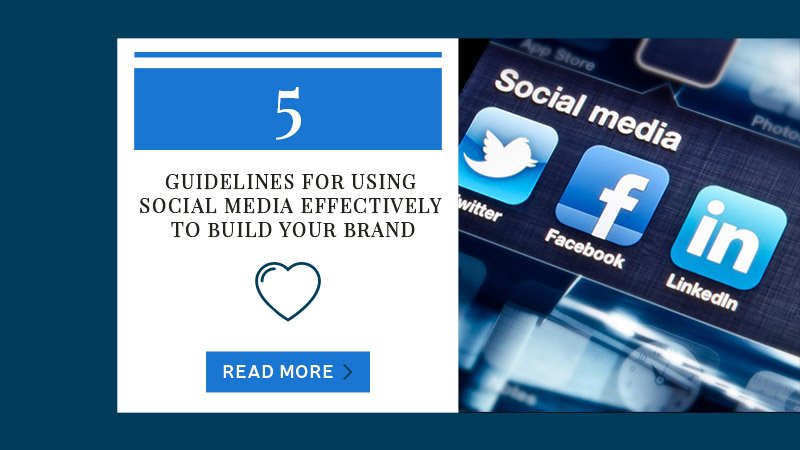Using social media in a business setting isn’t a new concept, yet many companies simply don’t see any value in it. To some, these websites might not seem like anything more than a place to share selfies, and pointless daily updates, but that couldn’t be further from the truth.
Every minute, there are meaningful conversations happening on social media, and to willingly exclude yourself from this expansive atmosphere is a disservice to your company. Twitter, Facebook, and other social sites are important to use, not only because there are tangible user benefits to them, but because your presence there also signals that you’re active in the social marketplace. If you or your brand is ready to join the digital world, make sure these 5 guidelines for using social media are understood before jumping in headfirst.
Use it
One of the most challenging aspects of starting a new social media account is the initial phase. It can be disheartening to send out tweets to a mere handful of followers, with limited visibility and minimal engagement. The prospect of speaking to an empty auditorium may even feel embarrassing.
However, it’s crucial to overcome this hurdle.
Every social media account, regardless of its eventual success, begins with zero followers, subscribers, and likes. Building a following is a gradual and time-consuming process, but it is undoubtedly worth starting now. There’s a saying that resonates with this situation, “The best time to plant a tree was 20 years ago. The second-best time is now” although it may not seem as profound in our context.
The ideal time to establish a social media account was five years ago, but the second-best time is now.
In the journey of expanding your user base, there’s a crucial point to remember: avoid buying followers. While it may boost your follower count and stroke your vanity, it holds no value if those followers don’t engage with you or care about your product. Buying followers is a waste of money, and platforms consistently crack down on fake and purchased accounts. It won’t help grow your user base, and there’s a high likelihood that your purchased followers will eventually be purged, forcing you to start from scratch. Moreover, the discovery of fake followers can lead to embarrassment and a loss of credibility.
Use relevant media
According to Kissmetrics, content with images gets 94% more views than those without. While that’s true, we need to clarify exactly what that means. It’s not enough to just attach a photo to a tweet, and sit back and watch it flourish. The image needs to be relevant to what your message is about.
If you see a Tweet with the text “Here’s how you can take advantage of social media” with a photo of a bushel of apples, chances are, you’re not going to click on that link.
However, finding a photo that perfectly matches your message is easier said than done. With Pixabay, Kaboompics, and other high-quality image sites, it’s likely that you can find something that’s at the very least tangentially related to your topic. Of course, there are paid alternatives which will open up a treasure trove of images, but if you’re stuck with a tight budget or none, you’re left without an easy solution. Fortunately, there are other alternatives.
If you find yourself having trouble nailing down that perfect image, why not try creating it? While that might sound like a tall task, with Canva, a site that provides you with easy and intuitive tools to design your own images, it’s simple. They have numerous pre-designed layout options, and thousands of photos, grids, frames, shapes, illustrations, icons, and charts for you to incorporate into your design. Long story short. Don’t settle for a photo that’s somewhat related to your topic. Create one that connects to your message.

An active social media account = increased customer loyalty
Having a social media account accomplishes a myriad of things, but out of all the benefits, there are two that stand out. The first is that it lets people know that your business is an active member of their social world. Without a way to connect with consumers and potential partners online, people may dismiss your company altogether.
When it comes to dealing with a business, I look for their channels on social media. If they don’t have a social presence, I don’t consider them serious in business. – Maria Johnsen
One compelling reason to maintain an active social media account is the establishment of loyalty between your company and both existing and potential customers. A study conducted by Texas Tech University reveals that companies that effectively utilize Twitter and engage in conversations with their followers are more likely to cultivate brand loyalty among these individuals.
The simple act of engaging with your customers can yield significant rewards. Just a few years ago, it was challenging for companies to communicate with individual customers. Contacting a support line often resulted in long wait times, ranging from non-existent to over an hour, which did little to foster customer loyalty or satisfaction. However, with the advent of social media, a consumer can now reach out to a company in seconds with just 140 characters and a click of a button, enabling their specific issues to be promptly addressed. This immediate and personalized interaction has revolutionized customer service and has the potential to enhance loyalty and satisfaction levels significantly.
Using social media correctly humanizes your company
Let’s conduct a quick experiment by comparing the official Twitter accounts of Microsoft and Starbucks. Despite both companies offering products and services that are deeply ingrained in our daily lives, their Twitter timelines present a stark contrast. Microsoft’s feed primarily consists of their tweets and retweets of articles mentioning their revolutionary products or featuring their CEO, Satya Nadella.
In contrast, Starbucks’ Twitter feed is filled with retweets from satisfied customers, creating an interactive and engaging experience. This allows their customers to establish a unique connection with the brand that goes beyond what Microsoft currently offers.
At present, Microsoft’s pinned tweet highlights Patrick De Armas, who utilizes the “Microsoft Surface Pro 3 to create and manage his work.” On the surface, this seems like the kind of content that Microsoft should be sharing on social media. It effectively showcases their product in a distinctive setting and reinforces the notion that the Surface is a versatile tool.
This message is ideal, powerful, and aligns with Microsoft’s objectives. However, the challenge lies in the fact that this specific example is part of their features program, which demands extensive planning. Such posts cannot happen spontaneously or organically. This doesn’t imply that these types of posts are inadequate; on the contrary, they are fantastic. However, Microsoft should also focus on leveraging posts like these and capitalizing on their potential impact.

In a remarkable display of customer care, Microsoft has demonstrated its commitment to the average consumer through a concise yet impactful post consisting of just 12 words and a single photo. This gesture highlights Microsoft’s dedication to ensuring that every user, regardless of their significance, is taken care of and valued. While the specific customer may not hold the same prominence as De Armas, the message conveyed is equally important, if not more so. By showcasing their concern for an individual who may only spend $250 annually, Microsoft exemplifies their commitment to customer-centricity. It is imperative for them to amplify this fact to their vast following of 7.74 million, reinforcing the message that every customer matters deeply to them.
Users want to feel like “there are actual people behind the accounts they are interacting with.” Unfortunately, not every company understands this and simply refuses to interact with the customers who populate their mentions.
5. You can convert on social media
The notion of turning social media activities like tweeting, posting on Facebook, and sharing on LinkedIn into actual sales may sound like a far-fetched idea, but it’s more than just a fairy tale. Social selling has revolutionized the way businesses engage with their customers, offering unique opportunities for personalized connections that were not available a decade ago. With the power of social media, you can now establish meaningful relationships with your customers on an individual level, nurturing trust and rapport that can eventually lead to tangible sales. By leveraging the tools and techniques of social selling, you can tap into the immense potential of these platforms to drive business growth and achieve remarkable results.
- Optimize your social media profiles
- Research your targets
- Listen
- Make connections. Initiate conversations.
- Be a source of excellent content
The world of social selling is here to stay, and it’s time you embrace its potential and leverage it to your advantage. Just as building a strong social media following doesn’t happen overnight, the results of your social selling efforts may also take time to materialize. However, with perseverance and dedication, the outcomes will undoubtedly be rewarding.
It’s essential to recognize the value of each social media platform at your disposal and understand how to make the most of them. Even seemingly unconventional platforms like Snapchat have their place in the business realm. Whether it’s promoting live events, offering glimpses into your company’s daily operations, or providing exclusive previews, these platforms can be powerful marketing tools. Stay open to emerging technologies and innovative ways to connect with your audience, as they may hold the key to unlocking unprecedented success for your business.









0 Comments